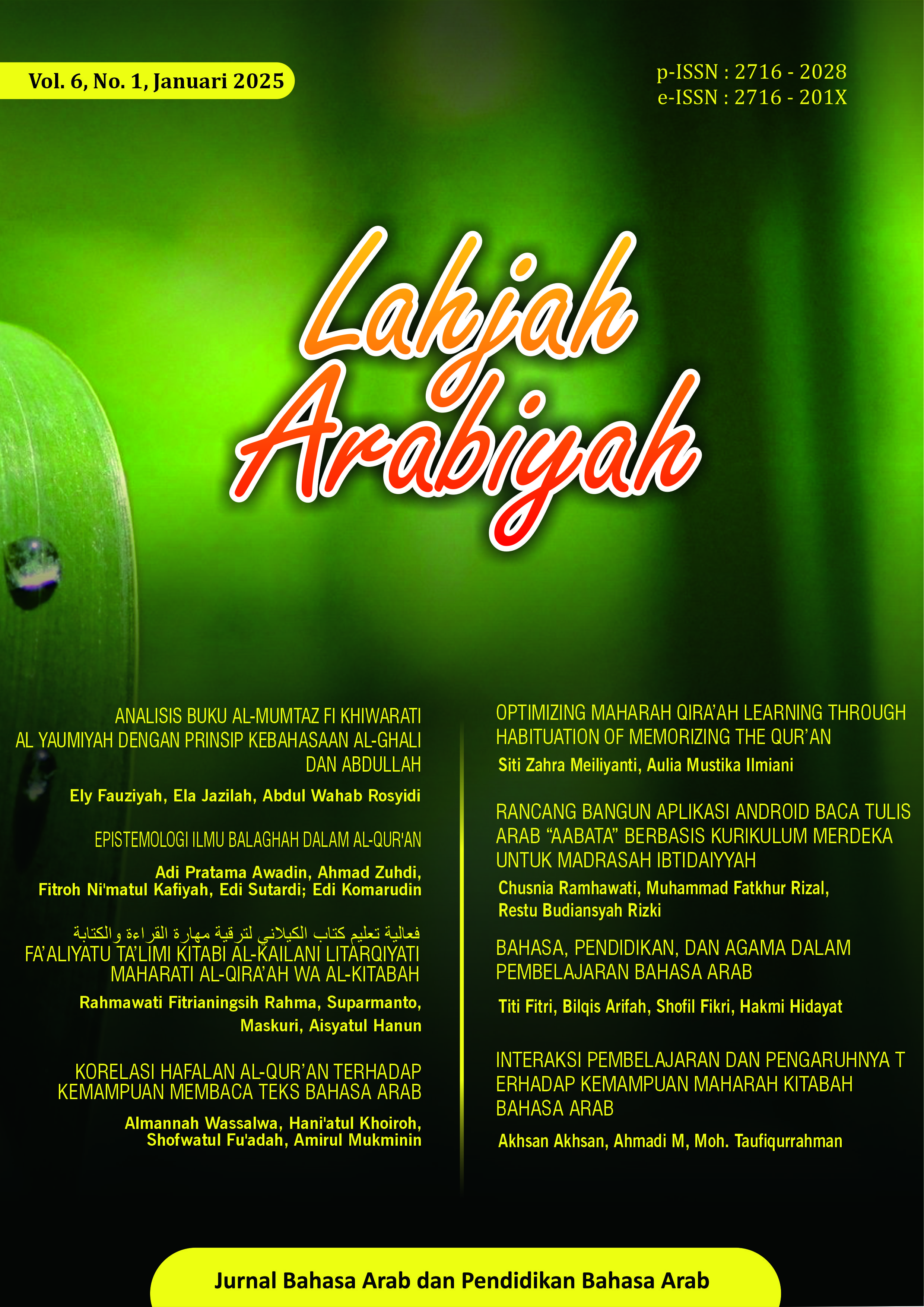EPISTEMOLOGI ILMU BALAGHAH DALAM AL-QUR'AN
DOI:
https://doi.org/10.35316/lahjah.v6i1.87-102Keywords:
Balaghah, Science, History, ExegesisAbstract
The science of balaghah in the language of the Qur'an has a crucial existence in obtaining the true meaning of the meaning of the language that has been conveyed. Balaghah science as a scientific discipline has three main aspects namely, ma'ani science, bayan science, and badi' science in an effort to see the intent of the speaker's message. This study discusses the scope of balaghah science. This research is a qualitative research with litserature study using descriptive analytical method. The results of this study reveal that balaghah as a science of balaghah has received a positive response from the scholars, there are historical dynamics in balaghah science, there are three main scopes of balaghah science, and there is a correlation of mufassir in interpreting the Qur'an. The beauty of the al-Qur'an language must be able to be revealed by the mufassir, so that the al-Qur'an can be understood from their own language.
Downloads
References
Abdul Rohman, and Wildan Taufiq. “Ilmu Ma’ani Dan Peranannya Dalam Tafsir.” Jurnal Al-Fanar 5, no. 1 (2022): 84–101. https://doi.org/10.33511/alfanar.v5n1.84-101.
Abdul Wahab Syakhrani, Saipul Rahli. “Latar Belakang Munculnya Ilmu Balaghah, Tokoh-Tokoh, Karya-Karyanya Dan Aspek-Aspeknya.” MUSHAF JOURNAL : Jurnal Ilmu Al Quran Dan Hadis 3, no. 1 (January 2023): 59–71. https://doi.org/10.54443/mushaf.v3i1.88.
Abdussamad, Zuchri. Metode Penelitian Kualitatif. Syakir Media Press, 2021.
Aisyatul Hanun, and Herizal Herizal. “MENINGKATKAN KETERAMPILAN BERBICARA BAHASA ARAB MELALUI PERMAINAN BAHASA ISYRUNA SUALAN.” Lahjah Arabiyah: Jurnal Bahasa Arab Dan Pendidikan Bahasa Arab 1, no. 1 (January 2020): 26–32. https://doi.org/10.35316/lahjah.v1i1.573.
Akhsan, Akhsan. “علم المعاني في كتاب البلاغة الواضحة لعلي الجارم ومصطفي أمين.” Lahjah Arabiyah: Jurnal Bahasa Arab Dan Pendidikan Bahasa Arab 1, no. 1 (January 2020): 1–10. https://doi.org/10.35316/lahjah.v1i1.569.
Al-Jarim, Ali, and Musthafa Amin. Terjemahan Al-Balaaghatul Waadhihah. 15th ed. Bandung: Penerbit Sinar Baru Algensindo Bandung, 2018.
Amrulloh, Muhammad Afif. “Kesamaan Bunyi Pada Sajak (Kajian Fonologi Al-Qur’an Dalam Surat Al-Asr).” Jurnal Al Bayan: Jurnal Jurusan Pendidikan Bahasa Arab 9, no. 1 (July 2017): 99–109. https://doi.org/10.24042/albayan.v9i1.1082.
Az-Zuhaili, Wahbah bin Musthofa. Tafsir Al-Munir Fi Al-Aqidah Wa Al-Syari’ah Wa Al-Manhaj. Maktabah Syamilah. Damaskus: Daar al-Fikr al-Ma’ashir, 1999.
Fadli, Muhammad Rijal. “Memahami Desain Metode Penelitian Kualitatif.” HUMANIKA 21, no. 1 (April 2021): 33–54. https://doi.org/10.21831/hum.v21i1.38075.
fitk.uinjkt. “Abdullah Ibn Al-Mu’tazz: Sang Kreator Ilmu Badi,” 2017.
Haeruddin. “Karakteristik Sastra Arab Pada Masa Pra-Islam.” Nady Al-Adab 13, no. 1 (2016): 35–50. https://doi.org/10.20956/jna.v13i1.3231.
Jidan, Fayyad. “Perkembangan Ilmu Balaghah.” Imtiyaz: Jurnal Ilmu Keislaman 6, no. 2 (July 2022): 142–50. https://doi.org/10.46773/imtiyaz.v6i2.355.
Kholison, M, Aidillah Suja, Cahya Edi Setyawan, and Ramandha Rudwi Hantoro. “Pengembangan Bahan Ajar Bahasa Arab Dengan Pendekatan Kemahiran Berbicara.” Lahjah Arabiyah: Jurnal Bahasa Arab Dan Pendidikan Bahasa Arab 4, no. 1 (2023): 90–91. https://doi.org/10.35316/lahjah.v4i1.90-102.
Masdar, Muhammad Ihsanuddin. “Pengembangan Bahan Ajar Ilmu Bayan Berbasis Analisis Kontrastif Di Program Studi Pendidikan Bahasa Arab Sekolah Tinggi Ilmu Al-Quran.” FENOMENA 11, no. 1 (June 2019): 31–46. https://doi.org/10.21093/fj.v11i1.1368.
Muhammad, Mahdir. “Esensitas Pembelajaran Balagah Al-Qur’an.” Jurnal Al-Fikrah 8, no. 1 (2019): 82–100. https://doi.org/10.54621/jiaf.v8i1.
Mulyawan, Sopwan. “Studi Ilmu Ma’Ani (Stylistic) Terhadap Ayat-Ayat Surat Yasin.” Holistik 12, no. 2 (2011): 97–113. https://doi.org/10.24235/holistik.v12i2.96.
Mushodiq, Muhamad Agus. “Majaz Al-Quran Pemicu Lahirnya Ilmu Balaghah (Telaah Pemikiran ‘Ali ‘Asyri Zaid).” An-Nabighoh 20, no. 01 (2018): 45–62. https://doi.org/10.32332/an-nabighoh.v20i01.
Muttaqin, Mohammad Izdiyan. “Afkar Amin Al-Khuli Fi Ta’lim Al-Balaghah Al-‘Arabiyah.” Arabiyat : Jurnal Pendidikan Bahasa Arab Dan Kebahasaaraban 4, no. 1 (June 2017): 38–57. https://doi.org/10.15408/a.v4i1.5323.
———. “Amin Al-Khuli: Raid Tajdid Al-Balaghah Fî Al-Ashr Al-Hadits.” Arabiyat : Jurnal Pendidikan Bahasa Arab Dan Kebahasaaraban 7, no. 2 (December 2020): 326–46. https://doi.org/10.15408/a.v7i2.17254.
Noor, Damhuri Dj. “Gaya Bahasa Al-Iltifat Al-Mu’jami Dalam Al-Qur’an.” Arabiyatuna : Jurnal Bahasa Arab 4, no. 1 (May 2020): 131–54. https://doi.org/10.29240/jba.v4i1.1357.
Rifai, Juhdi. “Pendekatan Ilmu Balaghah Dalam Shafwah Al-Tafâsîr Karya ‘Ali Al-Shabuny.” Jurnal Ulunnuha 8, no. 2 (March 2020): 245–66. https://doi.org/10.15548/ju.v8i2.1256.
Shihab, M. Quraish. “Membumikan” Al-Qur’an. 26th ed. Bandung: Penerbit Mizan, 2003.
Suryani, Khotimah. “Keunggulan Bahasa Al-Quran Di Bidang Sastra (Al-Balaghah) Dalam Pandangan Ibn Asyur.” Studi Keagamaan, Pendidikan Dan Humaniora 6, no. 2 (2019): 220–45. https://doi.org/10.52166/dar%20el-ilmi.v6i2.1652.
Suryaningsih, Iin, and Hendrawanto Hendrawanto. “Ilmu Balaghah: Tasybih Dalam Manuskrip ‘Syarh Fī Bayān Al-Majāz Wa Al-Tasybīh Wa Al-Kināyah.’” JURNAL Al-AZHAR INDONESIA SERI HUMANIORA 4, no. 1 (January 2018): 1. https://doi.org/10.36722/sh.v4i1.245.
Suyuthi, Imam. Al-Itqan Fi Ulumil Qur’an. 1st ed. Vol. 2. Surakarta: Indiva Pustaka, 2009.
Sya’bani, Muhammad Zaky. “Kajian Balaghah Dalam Al-Qur’an Surat Luqman.” Al-Fathin 2, no. 2 (2019): 197–210. https://doi.org/10.32332/al-fathin.v2i02.
Ummah, Siti Rohmatul. “Penggunaan Balaghatul Qur’an Sebagai Alternatif Pembelajaran Ilmu Balaghah.” Fikroh: Jurnal Pemikiran Dan Pendidikan Islam 14, no. 2 (July 2021): 158–83. https://doi.org/10.37812/fikroh.v14i2.221.
Yahya, Yuangga Kurnia. “Gaya Bahasa Tauriyah Dalam Al-Qur’an.” Arabiyatuna : Jurnal Bahasa Arab 2, no. 1 (June 2018): 35. https://doi.org/10.29240/jba.v2i1.364.
Yasin, Hadi. “Sisi Balaghah Dalam Tafsir Al-Baidhawy.” Tahdzib Al-Akhlaq: Jurnal Pendidikan Islam 3, no. 2 (July 2020): 41–61. https://doi.org/10.34005/tahdzib.v3i2.894.
Downloads
Published
How to Cite
Issue
Section
License
Authors who publish with this journal agree to the following terms:
- Authors retain copyright and grant the journal right of first publication with the work simultaneously licensed under a Creative Commons Attribution-ShareAlike 4.0 International License that allows others to share the work with an acknowledgement of the work's authorship and initial publication in this journal.
- Authors are able to enter into separate, additional contractual arrangements for the non-exclusive distribution of the journal's published version of the work (e.g., post it to an institutional repository or publish it in a book), with an acknowledgement of its initial publication in this journal.
- Authors are permitted and encouraged to post their work online (e.g., in institutional repositories or on their website) prior to and during the submission process, as it can lead to productive exchanges, as well as earlier and greater citation of published work.



























_by_Matematohir.jpg)


